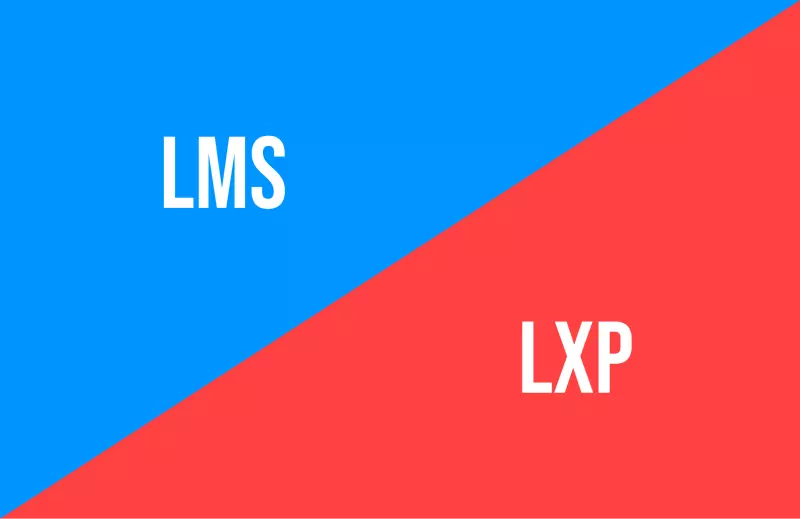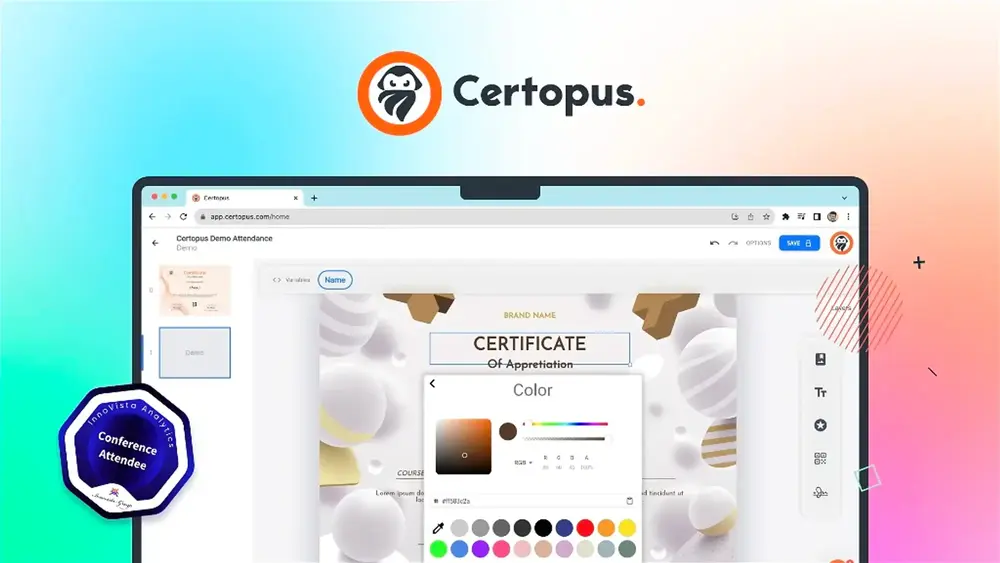Introduction
Learning Experience Platforms (LXP) and Learning Management Systems (LMS) are the most popular terms in e-learning industry. With these software programs, you may produce, distribute, oversee, and monitor online learning content. Nevertheless, they are appropriate for various contexts and goals because of their disparate methodologies, features, and functionalities.

In this article, we will explain what LMS and LXP are, how they differ from each other, what are their pros and cons, and how to choose the best one for your needs
What is a Learning Management System (LMS)?

A Learning Management System (LMS) is software that allows you to design, deliver, manage, and track online learning content. An LMS typically consists of two major components: a course creation tool and a course delivery platform. The course-building tool allows you to create online courses utilizing multimedia elements like text, videos, audio, quizzes, etc. The course delivery platform allows you to distribute and assign courses to your learners, track their progress and performance, and provide reports and analytics.
Benefits of LMS
Some of the benefits of LMS are:
- An LMS saves you time, money, and resources by creating and delivering online courses easily and efficiently.
- An LMS ensures the consistency and quality of your learning content and programs across your organization or institution.
- An LMS complies with your industry or sector's legal and ethical requirements and protects your learners and employees.
- An LMS increases the engagement and motivation of your learners by providing them with interactive and personalized courses and features.
- An LMS improves learners' and employees' retention and satisfaction by enhancing learning outcomes and experiences.
Drawbacks of LMS
Some of the Drawbacks of LMS are:
- An LMS can be rigid and inflexible, limiting your learners' and instructors' creativity and autonomy.
- An LMS can be siloed, reducing the relevance and diversity of your learning content and preventing the collaboration and sharing of knowledge and best practices.
- An LMS can be complex and difficult to use, requiring technical skills and increasing the frustration of your learners and instructors.
- An LMS can be costly and dependent, requiring IT support and maintenance and increasing the budget and resources of your learning project.
- An LMS can be outdated and irrelevant, failing to keep up with your industry's latest trends and developments.
What is a Learning Experience Platform (LXP)?

A learning experience platform (LXP) software tool allows you to develop, deliver, manage, and track online learning content. An LXP typically consists of three major components: a content aggregation tool, a content recommendation engine, and a learning record store. The content aggregation tool allows you to collect and curate online learning information from various internal and external sources, including blogs, podcasts, videos, articles, courses, etc.
The content recommendation engine allows you to personalize and recommend learning content to your learners based on their preferences, goals, interests, skills, behavior, etc. The learning record store allows you to save and retrieve your learners' learning data and actions, such as material consumption, feedback, and achievements.
Benefits of LXP
Some of the benefits of LXP are:
- An LXP, a software application, allows you to collect, curate, personalize, and recommend online learning content.
- An LXP lets you source and curate learning content from various internal and external sources and platforms.
- An LXP allows you to personalize and recommend the learning content to your learners based on their preferences, goals, behavior, etc.
- An LXP increases the engagement and retention of your learners by providing them with interactive and multimedia-rich learning content, gamification, social learning features, etc.
- An LXP fosters innovation and growth in your organization by enabling your learners to create and share their learning content and experiences with others.
Drawbacks of LXP
Some of the Drawbacks of LXP are:
- An LXP can compromise the quality and consistency of your learning content as it relies on unverified, outdated, or inappropriate sources and platforms.
- An LXP can pose security and compliance risks, as it allows access to and integration of your learning content and data.
- An LXP can be complex and difficult to use, as it requires multiple skills and knowledge to collect, curate, personalize, and recommend learning content.
- An LXP can be costly and dependent, requiring IT support and maintenance to operate and update the learning content.
LMS vs LXP: A comparison table
To summarize the differences between LMS and LXP, here is a comparison table that highlights the main aspects of each platform:
Aspect | LMS | LXP |
Definition | A software application that allows you to create, deliver, manage, and track online learning content. | A software application that allows you to collect, curate, personalize, and recommend online learning content. |
Approach | Formal and structured learning. | Informal and unstructured learning. |
Mode | Instructor-led. | Learner-led. |
Content | Closed and centralized. | Open and decentralized. |
Features | 1. Course creation and management. 2. Course delivery and assignment. 3. learner management and communication. 4. Progress and performance tracking. 5. Certification and accreditation. | 1. Content aggregation and curation. 2. Content personalization and recommendation. 3. Learner engagement and collaboration 4. Learning analytics and insights. |
Use cases | Corporate training, education, non-profit. | Employee development, customer education, community learning. |
Examples | Moodle, Canvas LMS, Thinkific, etc. | Degreed, Absorb, 360Learning, EdApp, etc. |
How to choose between LMS and LXP
Choosing between a Learning Management System (LMS) and a Learning Experience Platform (LXP) depends on your organization's specific needs. An LMS is ideal if your primary focus is on structured training, compliance, and tracking progress. LMS platforms excel in delivering and managing courses, assessments, and certifications.
On the other hand, if your organization values a more dynamic and personalized learning experience, emphasizing user-generated content, social learning, and collaboration, an LXP may be the better choice. LXPs prioritize learner engagement, offering a more flexible and interactive approach to training.
Ultimately, assess your organization's goals, the nature of your content, and the preferred learning culture. Consider whether a structured, compliance-oriented approach (LMS) or a more dynamic, user-centric approach (LXP) aligns better with your training objectives. In some cases, a combination of both systems might be the most effective solution.
How to issue certificates/badges with LMS or LXP?
If you are looking for a way to create and manage digital certificates for your online learning and training programs on a LMS or LXP, you might want to check out Certopus.

Certopus is a powerful and reliable platform for digital credentials. With Certopus, you can issue beautiful and secure digital badges and certificates that showcase your brand. Certopus aims to make your digital credentialing process seamless and forgery-free. You can design your own certificates and badges using templates or your own designs, bulk generate and automate credential issuance, and gain insights into the reach and impact of your credentials. Certopus is also fully compliant with the Open Badges standard, which means that your credentials are globally verifiable and shareable.
If you want to issue certificates and badges with your LMS or LXP, you should look for a solution that meets your needs and goals. Certopus is one of the best options available, as it is easy to use, flexible, and secure.
Frequently Asked Questions (FAQ)
Can an organization use both LMS and LXP?
Depending on the specific training needs, some organizations may benefit from using both LMS and LXP. While an LMS is great for delivering, managing, and measuring learning content consumption, an LXP emphasizes providing personalized learning experiences
Which one is more suitable for structured learning and compliance?
LMS is more concerned with data compliance and is suitable for structured learning, making it ideal for organizations that require order and structure in their learning programs
What is the main difference between an LMS and an LXP?
The main difference lies in their approach to learning. An LMS focuses more on formal, structured learning with features like course creation, management, and progress tracking. In contrast, an LXP emphasizes informal, unstructured learning, often driven by user-generated content, social learning, and personalized recommendations.
Need More Information?
Schedule a demo to learn more about Certopus for your business use case, or if you have any questions, don't hesitate to contact us. We would be delighted to assist you. Finally, if you're on social media, follow us to remain informed about our latest developments and learn more about digital credentials like certificates, badges, and micro-credentials.
Recommended Articles:



